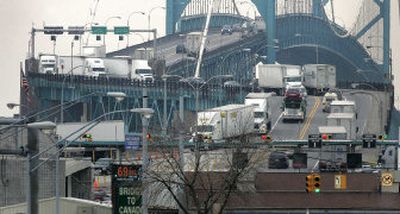Auto industry relies on one bridge

DETROIT – Thousands of cars cross the border between Detroit and Windsor, Ontario, each day – and that’s not even counting the ones that have drivers at the wheel.
These are vehicles fresh off the assembly line, as well as parts on their way to become vehicles. A stream of shipments flows both ways over the border as part of the regular course of business for the auto industry. Most of it travels over a single, privately owned, four-lane bridge.
The Ambassador Bridge is the busiest vehicle border crossing in North America and the auto industry’s main conduit between the United States and Canada. Ever since Sept. 11, 2001, officials in Michigan and Ontario and at the companies that rely on the bridge have been acutely aware of the danger of this near monopoly.
A joint Canadian-U.S. commission has been studying where to build another crossing, but a new bridge won’t be operational until 2013. Until then, the entire auto industry continues to rely on one bridge owned by one man, Manuel “Matty” Moroun.
“It’s kind of shocking that a private investor can own a crossing between two countries,” said Kim Hill, an analyst with the Center for Automotive Research in Ann Arbor. “He can impact two very large state and provincial economies.”
In Detroit, the Ambassador Bridge competes with the Detroit-Windsor Tunnel for passenger traffic. But the tunnel allows only a limited number of trucks, cannot accommodate bigger ones, and is located between two downtowns. So for big semitrailers, the nearest alternative to the Ambassador Bridge is the Blue Water Bridge, connecting Port Huron, Mich. and Sarnia, Ontario, about 60 miles to the northeast.
Government and industry started paying attention to the border issue after the terrorism attacks, when the sudden boost in security led to backups of up to 17 hours, said Tom Wickham, a GM spokesman.
The potential for future delays is worrisome for an industry that years ago moved to “just-in-time” manufacturing, in which there are no large warehouses and deliveries of parts are timed precisely to when they are needed at plants.
According to the Federal Highway Administration, there are seven privately owned border crossings – three on the Canadian border, including a Detroit ferry service for trucks carrying hazardous materials, and four in Texas. None of the others, however, approaches the significance of the Ambassador Bridge.
One thing all sides seem to agree on is that sooner or later, there will be a need for more border-crossing capacity between Detroit and Windsor. The binational commission forecasts that traffic at the Ambassador Bridge will reach capacity by 2010.
Moroun’s company wants to address that need by building a twin span or a wider replacement span right alongside the Ambassador Bridge.
But the company’s plan is not enough for the border commission.
It studied the idea of twinning the bridge, but said it would not provide what is known as “redundancy,” an alternative if the bridge is shut down. Officials are looking to build a completely separate span.